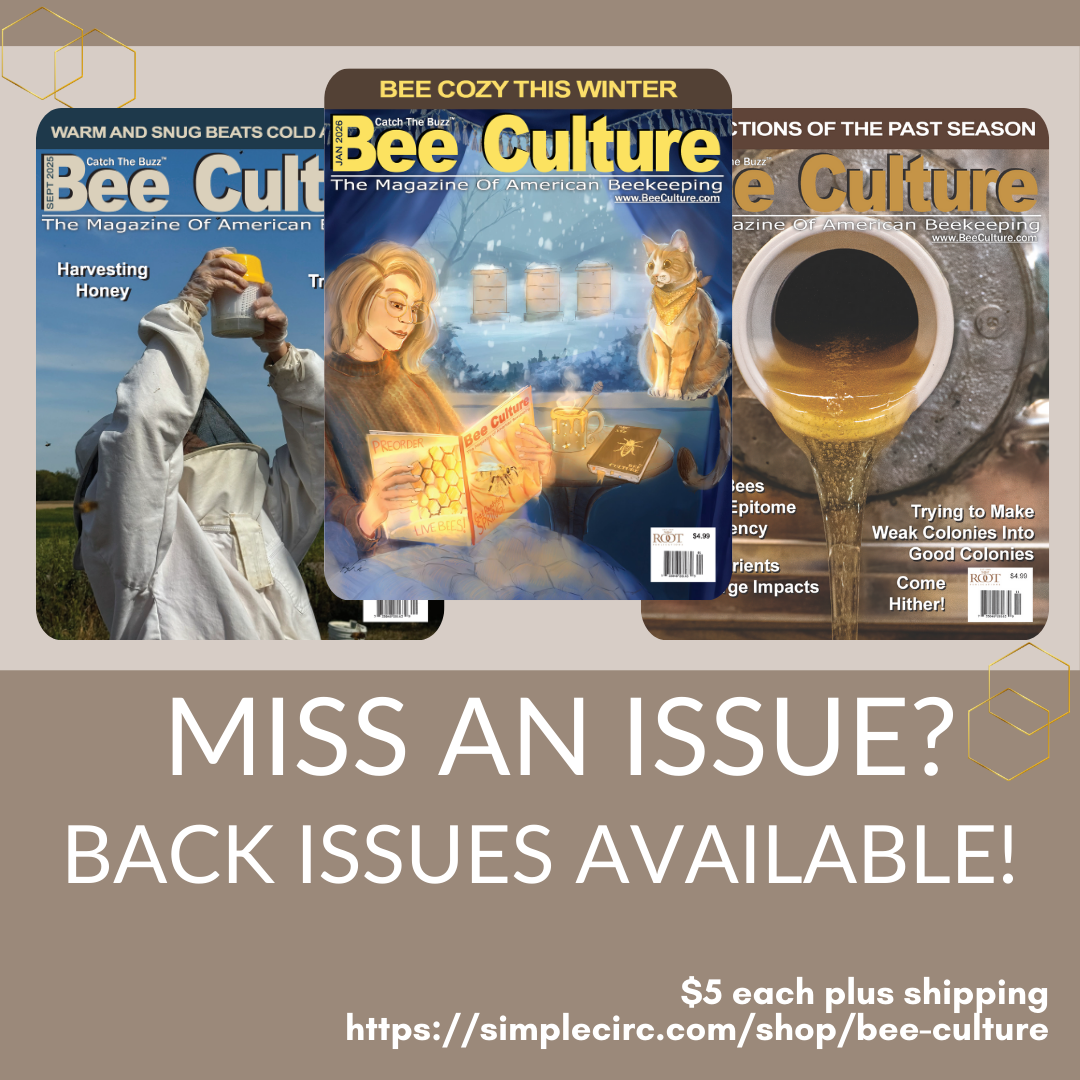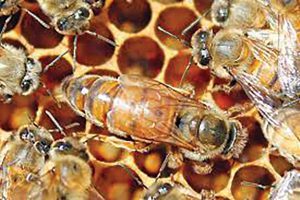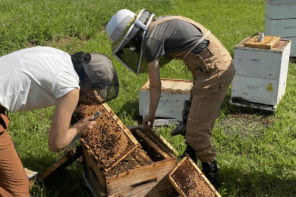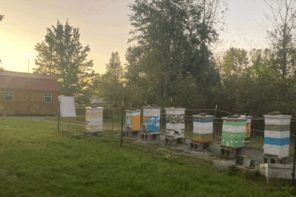 Queen Health
Queen Health
The reproductive quality and health of a queen are essential to ensure colony growth.
Clarence Collison
Managed honey bee colonies face multiple health risks including nutritional stress, exposure to pests and pathogens, poor queen quality, and pesticide contamination, which cause problems at the individual and colony levels. The reproductive quality (fertility and fecundity) and health of a queen are essential to ensure colony growth, survival, and productivity.
“Several factors have been identified that may ultimately affect the quality and productivity of the honey bee queen. In colonies, honey bees are normally adept at thermoregulating (Stabentheiner et al. 2010), but queens are vulnerable to heat-shock and cold-shock events during shipping (Pettis et al. 2016; McAfee et al. 2020a), where they are regularly transported long distances via ground or air cargo in poorly thermoregulated environments (Withrow et al. 2019). In a colony, worker bees can try to lessen the effects of overheating by collecting water and fanning to achieve evaporative cooling, or by heat-shielding, using their own bodies as heat-blocking insulation (Stabentheiner et al. 2010; Starks and Gilley 1999). Likewise, they can mitigate chilling by vibrating their wing muscles to generate heat (Stabentheiner et al. 2010). However, in small queen cages used for shipping, there is often limited (if any) water, poor ventilation and too few workers to effectively cool or heat the queen. Temperature loggers have been included in long distance queen shipments and have shown that both hot and cold temperature spikes regularly occur (Pettis et al. 2016; McAfee et al. 2020a) (McAfee et al. 2020b).”
“In an egg-laying queen, the ovaries occupy most of the abdominal cavity (Winston 1987). The weight of ovaries has been investigated as one of the physical criteria to assess the reproductive potential of queens (Kahya et al. 2008; Gregorc and Škerl 2015; Gilley et al. 2003). Ovaries of virgin queens are morphologically different and smaller compared to egg-laying queens (Shehata et al. 1981; Patricio and Cruz-Landim 2002) because well-developed ovaries are required for egg production, the ovaries of egg-laying queens are about eight times larger than those in virgins (Shehata et al. 1981). Ovary development occurs soon after mating and is associated with distinct gene-expression patterns in the brain and ovaries, physiological, and behavioral changes in the queen (Richard et al. 2007; Kocher et al. 2008; Niño et al. 2013). The weight of ovaries in a mature egg-laying queen not only depends on the number of ovarioles but also on the number and developmental stage of eggs in them. During winter, egg-laying activity by queens decreases or stops, which results in the queen having smaller and less-developed ovaries (Shehata et al. 1981). Ovary size and fertility are usually positively correlated (Tarpy et al. 2000). However, under certain circumstances, perhaps due to stress or disease, this relation may not hold (Kahya et al. 2008), (Amiri et al. 2017).”
“Recently, queen failure has been proposed to be a major driver of managed honey bee colony losses yet few data exist concerning effects of environmental stressors on queens. Williams et al. (2015) demonstrated for the first time that exposure to field realistic concentrations of neonicotinoid pesticides during development can severely affect queens. In pesticide-exposed queens, reproductive anatomy (ovaries) and physiology (spermathecal-stored sperm quality and quantity), rather than flight behavior, were compromised and likely corresponded to reduced queen success (alive and producing worker offspring).”
“Many factors can negatively affect honey bee health including the pervasive use of systemic neonicotinoid insecticides. Through direct consumption of contaminated nectar and pollen from treated plants, neonicotinoids can affect foraging, learning and memory in bees. Less well studied are the potential effects of neonicotinoids on queen bees, which may be exposed indirectly through trophallaxis, or food sharing. To assess effects on queen productivity, small colonies of different sizes (1500, 3000 and 7000 bees) were fed imidacloprid (0, 10, 20, 50 and 100 ppb) in syrup for three weeks. Wu-Smart and Spivak (2016) found adverse effects of imidacloprid on queens (egg-laying and locomotor activity), worker bees (foraging and hygienic activities), and colony development (brood production and pollen stores) in all treated colonies. Some effects were less evident as colony size increased, suggesting that larger colony populations may act as a buffer to pesticide exposure. This study was the first to show adverse effects of imidacloprid on queen bee fecundity and behavior and improved our understanding of how neonicotinoids may impair short-term colony functioning. These data indicate that risk-mitigation efforts should focus on reducing neonicotinoid exposure in the early spring when colonies are smallest and queens are vulnerable to exposure.”
“Colony-level neonicotinoid exposure has negative effects on reproductive fitness of honey bee queens. However, it is unclear if the observed effects are a direct outcome of neonicotinoid toxicity or result from suboptimal care of developing queens by exposed workers. Kozii et al. (2021) evaluated larval survival, reproductive fitness and histopathology of honey bee queens exposed to incremental doses (0, 5, 50 ng) of the neonicotinoid thiamethoxam (THI) applied directly to individual late larvae (7 days post-oviposition) of queens. The 5 ng dose represents a calculated high environmental level of exposure for honey bee queen larvae. Morphometric evaluation revealed that the total area of mandibular gland epithelium in queens exposed to 5 and 50 ng THI was reduced by 14% and 25%, respectively. Decreased mandibular gland size may alter pheromone production, which could in part explain previously observed negative effects of THI on the reproductive fitness of queens. They also found that late larval exposure to THI reduced larval and pupal survival and decreased sperm viability in mated queens. These changes may interfere with queen development and reproductive longevity.”
“Queen failure is considered a relevant cause of colony losses, yet few data exist concerning the effects of environmental stressors on queens. Brandt et al. (2017) demonstrated that exposure to field-realistic concentrations of neonicotinoid pesticides can severely affect the immunocompetence of honey bee queens. In young queens exposed to thiacloprid (200 μg/l or 2000 μg/l) or clothianidin (10 μg/l or 50 μg/l), the total hemocyte number and the proportion of active, differentiated hemocytes was significantly reduced. Moreover, functional aspects of the immune defense namely the wound healing/melanization response, as well as the antimicrobial activity of the hemolymph were impaired. Their results demonstrate that neonicotinoid insecticides can negatively affect the immunocompetence of queens, possibly leading to an impaired disease resistance capacity.”
“Stressful conditions during development can have sub-lethal consequences on organisms aside from mortality. Using previously reported in-hive residues from commercial colonies, Milone and Tarpy (2021) examined how multi-pesticide exposure can influence queen health. They reared queens in beeswax cups with or without a pesticide treatment within colonies exposed to treated or untreated pollen supplement. Following rearing, queens were open-mated and then placed into standard hive equipment in an “artificial swarm” to measure subsequent colony growth. Their treated wax had a pesticide Hazard Quotient comparable to the average in beeswax from commercial colonies, and it had no measurable effects on queen phenotype. Conversely, colonies exposed to pesticide-treated pollen had a reduced capacity for viable queen production, and among surviving queens from these colonies they observed lower sperm viability. They found no difference in queen mating number across treatments. Moreover, they measured lower brood viability in colonies later established by queens reared in treated-pollen colonies. Interestingly, royal jelly from colonies exposed to treated pollen contained negligible pesticide residues, suggesting the indirect social consequences of colony-level pesticide exposure on queen quality. These findings highlight how conditions during developmental can impact queens long into adulthood, and that colony-level pesticide exposure may do so indirectly.”
“Pesticides have often been associated with queen loss and premature supersedure. Prior research has investigated the effects of indirect pesticide exposure on queens via workers, as well as direct effects on queens during development. However, as adults, queens are in constant contact with wax as they walk on comb and lay eggs; therefore, direct pesticide contact with adult queens is a relevant but seldom investigated exposure route. McAfee et al. (2021) conducted laboratory and field experiments to investigate the impacts of topical pesticide exposure on adult queens. They tested six pesticides commonly found in wax: coumaphos, tau-fluvalinate, atrazine, 2,4-DMPF, chlorpyriphos, chlorothalonil, and a cocktail of all six, each administered at 1, 4, 8, 16 and 32 times the concentrations typically found in wax. They found no effect of any treatment on queen mass, sperm viability, or fat body protein expression. In a field trial testing queen topical exposure of a pesticide cocktail, they found no impact on egg-laying pattern, queen mass, emergence mass of daughter workers, and no proteins in the spermathecal fluid were differentially expressed. These experiments consistently showed that pesticides commonly found in wax have no direct impact on queen performance, reproduction, or quality metrics at the doses tested. They suggested that previously reported associations between high levels of pesticide residues in wax and queen failure are most likely driven by indirect effects of worker exposure (either through wax or other hive products) on queen care or queen perception.”
“Among many environmental stresses, viruses are a major concern to compromise the queen’s health and reproductive vigor. Viruses have evolved numerous strategies to infect queens either via vertical transmission from the queens’ parents or horizontally through the worker and drones with which she is in contact during development, while mating, and in the reproductive period in the colony. Over 30 viruses have been discovered from honey bees but only few studies exist on the pathogenicity and direct impact of viruses on the queen’s phenotype. Amiri et al. (2020) described a study on sublethal effects of Israeli Acute Paralysis Virus (IAPV) that led to inconclusive results.”
References
Amiri, E., M.K. Strand, O. Rueppell and D.R. Tarpy 2017. Queen quality and the impact of honey bee diseases on queen health: potential for interactions between two major threats to colony health. Insects 8:48 doi:10.3390/insects8020048
Amiri, E., M.K. Strand, D.R. Tarpy and O. Rueppell 2020. Honey bee queens and virus infections. Viruses 12:322. doi: 10.3390/v12030322.
Brandt, A., K. Grikscheit, R. Siede, R. Grosse, M.D. Meixner and R. Büchler 2017. Immunosuppression in honeybee queens by the neonicotinoids. Thiacloprid and Clothianidin. Sci. Rep. 7: 4673.
Gilley, D.C., D.R. Tarpy and B.B. Land 2003. Effect of queen quality on interactions between workers and dueling queens in honeybee (Apis mellifera L.) colonies. Behav. Ecol. Sociobiol. 55: 190-196.
Gregorc, A. and M.I.S. Škerl 2015. Characteristics of honey bee (Apis mellifera carnica Pollman, 1879) queens reared in Slovenian commercial breeding stations. J. Apic. Sci. 59: 5-12.
Kahya, Y., H.V. Gencer and J. Woyke 2008. Weight at emergence of honey bee (Apis mellifera caucasica) queens and its effect on live weights at the pre and post mating periods. J. Apic. Res. 47: 118-125
Kocher, S.D., F.-J. Richard, D.R. Tarpy and C.M. Grozinger 2008. Genomic analysis of post-mating changes in the honey bee queen (Apis mellifera). BMC Genom. 9: 232.
Kozii, I.V., S. Barnsley, M.C. Bezerra da Silva, S.C. Wood, C.D. Klein, I.M. de Mattos, M.W. Zabrodski, R. de C.M. Silva, C.I.O. Fabela, L. Guillemin, I. Dvylyuk, M.C.O. Ferrari and E. Simko 2021. Reproductive fitness of honey bee queens exposed to thiamethoxam during development. Vet. Pathol. XX(X): 1-12. (In Press)
McAfee, A., A. Chapman, H. Higo, R. Underwood, J. Milone, L.J. Foster, M.M. Guarna, D.R. Tarpy and J.S. Pettis 2020a. Vulnerability of honey bee queens to heat-induced loss of fertility. Nature Sustainability. 3: 367-376.
McAfee, A., J. Milone, A. Chapman, L.J. Foster, J.S. Pettis, and D.R, Tarpy 2020b. Candidate stress biomarkers for queen failure diagnostics. BMC Genom. 21: 571.
McAfee, A., J.P. Milone, B. Metz, E. McDermott, L.J. Foster and D.R. Tarpy 2021. Honey bee queen health is unaffected by contact exposure to pesticides commonly found in beeswax. Sci. Rep. 11: 15151
Milone, J.P. and D.C. Tarpy 2021. Effects of developmental exposure to pesticides in wax and pollen on honey bee (Apis mellifera) queen reproductive phenotypes. Sci. Rep. 11: 1020.
Niño, E.L., D.R. Tarpy and C.M. Grozinger 2013. Differential effects of insemination volume and substance on reproductive changes in honey bee queens (Apis mellifera L.) Insect Mol. Biol. 22: 233-244.
Patricio, K. and C. Cruz-Landim 2002. Mating influence in the ovary differentiation in adult queens of Apis mellifera L. (Hymenoptera: Apidae). Braz. J. Biol. 62: 641-649.
Pettis, J.S., N. Rice, K. Joselow, D. vanEngelsdorp and V. Chaimanee 2016. Colony failure linked to low sperm viability in honey bee (Apis mellifera) queens and an exploration of potential causative factors. PLoS ONE 11(2): e0147220. doi:10.1371/journal.pone.0147220
Richard, F-J., D. R. Tarpy and C.M. Grozinger 2007. Effects of insemination quantity on honey bee queen physiology. PloS ONE 2(10): e980. doi:10.1371/journal.pone.0000980
Shehata, S.M., G.F. Townsend and R.W. Shuel 1981. Seasonal physiological changes in queen and worker honeybees. J. Apic. Res. 20: 69-78.
Stabentheiner, A., H. Kovac and R. Brodschneider 2010. Honeybee colony thermoregulation-regulatory mechanisms and contribution of individuals in dependence on age, location and thermal stress. PLoS One 5:e8967.
Starks, P.T. and D.C. Gilley 1999. Heat shielding: a novel method of colonial thermoregulation in honey bees. Naturwissenschaften. 86: 438-440.
Tarpy, D.R., S. Hatch and D.J.C. Fletcher 2000. The influence of queen age and quality during queen replacement in honeybee colonies. Anim. Behav. 59: 97-101.
Williams, G.R., A. Troxler, G. Retschnig, K. Roth, O. Yañez, D. Shutler, P. Neumann and L. Gauthier 2015. Neonicotinoid pesticides severely affect honey bee queens. Sci. Rep. 5: 14621.
Winston, M.L. 1987. The Biology Of The Honey Bee. Harvard University Press, Cambridge, MA, 281 pp.
Withrow, J.M., J.S. Pettis and D.R. Tarpy 2019. Effects of temperature during package transportation on queen establishment and survival in honey bees (Hymenoptera: Apidae). J. Econ. Entomol. 112: 1043-1049.
Wu-Smart, J. and M. Spivak 2016. Sub-lethal effects of dietary neonicotinoid insecticide exposure on honey bee queen fecundity and colony development. Sci. Rep. 6: 32108. doi:10.1038/srep32108
Clarence Collison is an Emeritus Professor of Entomology and Department Head Emeritus of Entomology and Plant Pathology at Mississippi State University, Mississippi State, MS.










